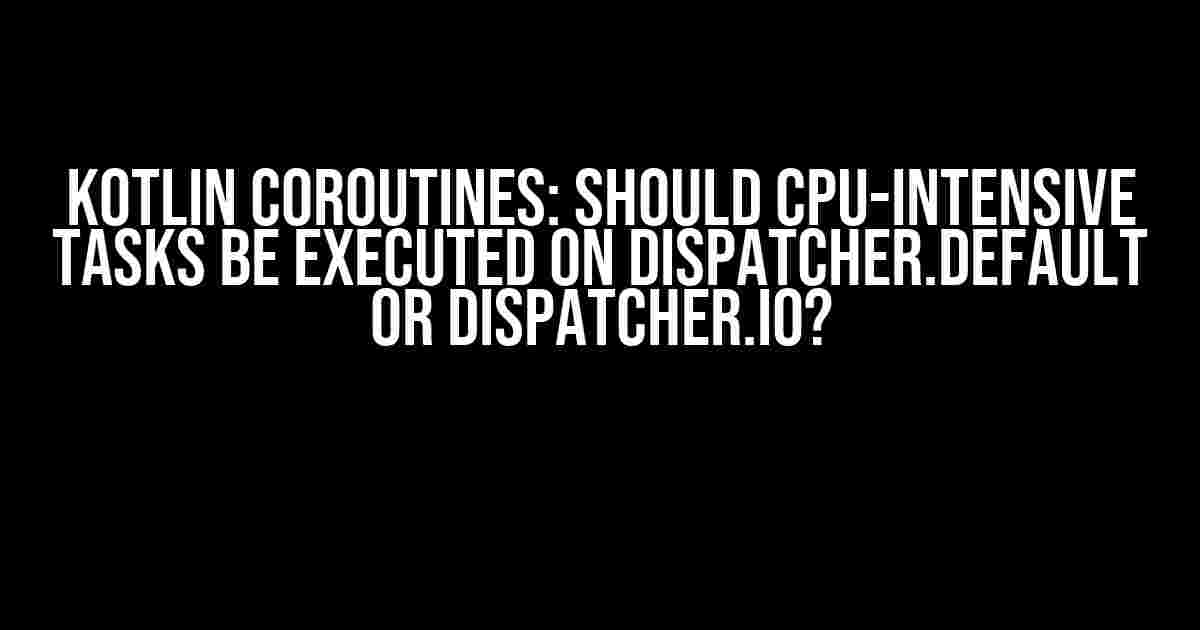Kotlin Coroutines have revolutionized the way we write asynchronous code in Android. With its simplicity and efficiency, it’s no wonder why many developers have adopted it as their go-to concurrency solution. However, one question that often arises is: “Should CPU-intensive tasks be executed on Dispatcher.Default or Dispatcher.IO?” In this article, we’ll dive deep into the world of Kotlin Coroutines and explore the answer to this question.
What are Kotlin Coroutines?
Kotlin Coroutines are a way of writing asynchronous code that’s concise, efficient, and easy to read. They’re built on top of the concept of suspending functions, which allow a function to pause its execution at certain points and resume later. This enables coroutines to achieve concurrency without blocking threads.
suspend fun myFunction() {
// some long-running operation
delay(1000)
// more code
}
In the above example, the `delay` function is a suspending function that pauses the execution of `myFunction` for 1 second. During this time, the thread is free to execute other tasks, making it non-blocking.
What are Dispatchers?
In Kotlin Coroutines, a Dispatcher is an abstract class that defines the context in which a coroutine runs. It determines the thread(s) on which the coroutine will execute. There are three main dispatchers: `Dispatcher.Default`, `Dispatcher.IO`, and `Dispatcher.Main`.
| Dispatcher | Description |
|---|---|
| Dispatcher.Default | |
| Dispatcher.IO | A dispatcher that uses a thread pool optimized for I/O operations. It’s suitable for tasks that involve I/O, such as network requests or database queries. |
| Dispatcher.Main | A dispatcher that runs coroutines on the main thread. It’s suitable for tasks that need to interact with the UI. |
CPU-intensive tasks: Dispatcher.Default or Dispatcher.IO?
Now, let’s get to the burning question: Should CPU-intensive tasks be executed on `Dispatcher.Default` or `Dispatcher.IO`? The answer lies in understanding the nature of CPU-intensive tasks and the characteristics of each dispatcher.
CPU-intensive tasks and Dispatcher.Default
CPU-intensive tasks, such as complex calculations, data compression, or encryption, are best suited for `Dispatcher.Default`. This dispatcher uses a thread pool to execute coroutines, which is ideal for CPU-bound tasks.
GlobalScope.launch(Dispatchers.Default) {
// CPU-intensive task
val result = complexCalculation()
// more code
}
By using `Dispatcher.Default`, you ensure that your CPU-intensive task is executed on a thread that’s optimized for processing. This prevents blocking the main thread and keeps your app responsive.
CPU-intensive tasks and Dispatcher.IO
However, if your CPU-intensive task involves I/O operations, such as reading or writing files, `Dispatcher.IO` might be a better choice. This dispatcher is optimized for I/O-bound tasks and provides better performance when dealing with disk I/O or network requests.
GlobalScope.launch(Dispatchers.IO) {
// CPU-intensive task with I/O operations
val data = readLargeFile()
val result = complexCalculation(data)
// more code
}
In this scenario, using `Dispatcher.IO` ensures that your I/O-bound task is executed on a thread that’s optimized for I/O operations, which can improve performance.
Best Practices for using Dispatchers
To ensure efficient and safe concurrency, follow these best practices when using dispatchers:
-
Use `Dispatcher.Default` for CPU-intensive tasks that don’t involve I/O operations.
-
Use `Dispatcher.IO` for I/O-bound tasks or CPU-intensive tasks that involve I/O operations.
-
Avoid using `Dispatcher.Main` for CPU-intensive tasks, as it can block the main thread and make your app unresponsive.
-
Use `withContext` instead of `launch` or `async` to specify the dispatcher for a specific coroutine scope.
-
Monitor your app’s performance and adjust the dispatcher accordingly. You may need to experiment with different dispatchers to find the optimal solution.
Conclusion
In conclusion, the choice between `Dispatcher.Default` and `Dispatcher.IO` for CPU-intensive tasks depends on the nature of the task. If your task is purely CPU-bound, `Dispatcher.Default` is the way to go. However, if your task involves I/O operations, `Dispatcher.IO` might provide better performance. By following best practices and understanding the characteristics of each dispatcher, you can write efficient and safe concurrent code using Kotlin Coroutines.
FAQs
Q: What is the default dispatcher used by Kotlin Coroutines?
A: The default dispatcher used by Kotlin Coroutines is `Dispatcher.Default`.
Q: Can I use Dispatcher.IO for CPU-intensive tasks that don’t involve I/O operations?
A: While you can use `Dispatcher.IO` for CPU-intensive tasks, it’s not recommended. `Dispatcher.IO` is optimized for I/O-bound tasks and may not provide the best performance for CPU-bound tasks. Use `Dispatcher.Default` instead.
Q: How do I switch between dispatchers in a coroutine?
A: You can use `withContext` to switch between dispatchers in a coroutine. For example:
GlobalScope.launch(Dispatchers.Default) {
// CPU-intensive task
withContext(Dispatchers.IO) {
// I/O-bound task
}
}
In this example, the coroutine starts on `Dispatcher.Default` but switches to `Dispatcher.IO` for the I/O-bound task.
Frequently Asked Question
Kotlin Coroutines have got the world of asynchronous programming by storm, but there’s still some confusion about where to execute those CPU-intensive tasks. Should you opt for Dispatcher.Default or Dispatcher.IO? Let’s dive in and find out!
Q1: What’s the difference between Dispatcher.Default and Dispatcher.IO?
Dispatcher.Default is designed for CPU-intensive tasks, whereas Dispatcher.IO is meant for I/O-bound operations like network requests or database queries. Think of it like this: Default is for tasks that make your processor sweat, while IO is for tasks that make your network or disk work hard!
Q2: Should I use Dispatcher.Default for tasks like image processing or data encryption?
Absolutely! Tasks like image processing or data encryption are CPU-intensive, so using Dispatcher.Default is the way to go. This ensures that your app remains responsive while these tasks are being executed in the background.
Q3: What happens if I use Dispatcher.IO for CPU-intensive tasks?
Big no-no! Using Dispatcher.IO for CPU-intensive tasks can lead to thread starvation, causing your app to become unresponsive or even crash. Keep your CPU-bound tasks on Dispatcher.Default to avoid any potential bottlenecks!
Q4: Can I use Dispatcher.Default for I/O-bound operations like API calls or database queries?
Not recommended! Dispatcher.Default is not designed for I/O-bound operations, which can lead to thread blocking and performance issues. For I/O-bound tasks, stick with Dispatcher.IO to keep your app running smoothly.
Q5: What’s the best practice for choosing between Dispatcher.Default and Dispatcher.IO?
Simple: ask yourself, “Is this task CPU-intensive or I/O-bound?” If it’s CPU-intensive, go with Dispatcher.Default. If it’s I/O-bound, opt for Dispatcher.IO. Remember, context is key, so consider the nature of your task and choose the dispatcher that fits best!



